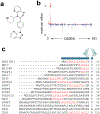Context-Specific Action of Ribosomal Antibiotics
- PMID: 29906204
- PMCID: PMC8742604
- DOI: 10.1146/annurev-micro-090817-062329
Context-Specific Action of Ribosomal Antibiotics
Abstract
The ribosome is a major antibiotic target. Many types of inhibitors can stop cells from growing by binding at functional centers of the ribosome and interfering with its ability to synthesize proteins. These antibiotics were usually viewed as general protein synthesis inhibitors, which indiscriminately stop translation at every codon of every mRNA, preventing the ribosome from making any protein. However, at each step of the translation cycle, the ribosome interacts with multiple ligands (mRNAs, tRNA substrates, translation factors, etc.), and as a result, the properties of the translation complex vary from codon to codon and from gene to gene. Therefore, rather than being indiscriminate inhibitors, many ribosomal antibiotics impact protein synthesis in a context-specific manner. This review presents a snapshot of the growing body of evidence that some, and possibly most, ribosome-targeting antibiotics manifest site specificity of action, which is modulated by the nature of the nascent protein, the mRNA, or the tRNAs.
Keywords: antibiotic; chloramphenicol; erythromycin; kasugamycin; ketolides; linezolid; macrolides; nascent peptide exit tunnel; pactamycin; peptidyl transferase center; protein synthesis; resistance; ribosome; translation.
Figures







References
Publication types
MeSH terms
Substances
Grants and funding
LinkOut - more resources
Full Text Sources
Other Literature Sources
Medical

